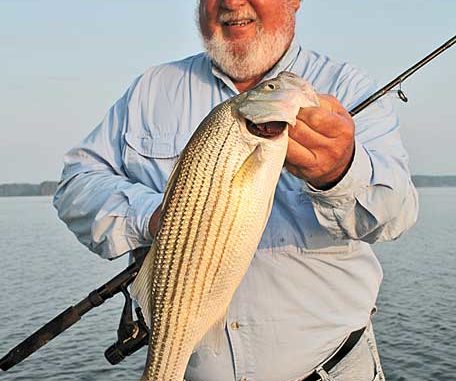
November brings a lot of reasons to be excited about fishing at Lake Marion and Lake Moultrie, but right at the top of the list is striper fishing. The requirement to release all stripers has ended, and November is typically topwater schooling time. Plus, the live-bait drift fishing is excellent.
According to guide Alan Spence of Spence’s Guide Service (803-983-8284), the fishing may be better this year than in the past two or three years.
“I’m seeing more striper activity and hearing more positive reports,” Spence said. “I’m not saying the fishing will be great, but I think it will be better, and overall, it seems to be headed in the right direction. November should be a really good month for a lot of fishermen because the catfish action is also excellent, and we’ll have stripers to chase as well.”
Spence said the striper action will be productive on topwater schooling fish as well as drifting live bait for suspended fish. The live bait is his preferred tactic, partly because with a guide party, slinging all those treble hooks can create problems.
“Live bait is my No. 1,” he said. “I’ll drift fish with herring, shad or shiners, and all are excellent baits to catch some big stripers. I’ll use the herring or shad primarily when available, but I’m set up with a big, round tank especially for this bait. If fishermen want to fish live bait but don’t have the right tank to keep shad and herring alive, the shiners can be kept alive in a regular minnow bucket and will produce fish.”
Spence said fishing in both lakes is good at this time of the year.
“Most of the action on Lake Marion will be in the main lake, often in the trees” he said. “In November, we’ll also find some fish in the mouths of Wyboo, Taw Caw and other major creeks, so don’t overlook those areas. Lake Moultrie is also excellent in the open-water areas.”
Spence looks for big schools or pods of shad. Many times they’ll be in the “dead-tree” areas on the lower end of the Lake Marion, but not always.
“The key to November stripers is finding shad,” Spence said. “I’ll usually mark fish suspended around the shad or near them. That gives you the location and depth to fish. On some days, I’ll catch fish from 25 feet of water on the bottom all the way up to the surface on the free lines. Don’t get locked into a single depth. Stripers move around a lot.
“I generally fish both down rigs and freelines,” Spence said. “The down rig is suspended below the boat at the depth, or just above, where I mark fish. Free lines are drifted behind the boat. Also, don’t be surprised if a big catfish takes the live bait on either rig. We’ll occasionally catch some 30-pound-plus catfish when striper fishing, which makes a great bonus.”
Spence will occasionally use half-ounce Hopkins spoons and vertical-jig for stripers when he get them stacked under the boat.
“Spoons are great artificial lures and very productive at times,” he said. “In addition, a lot of fishermen chasing the schooling fish will use Striper Swipers, bucktails and Pop Rs.”
Spence said the local guides are optimistic that new regulations will help the fishery, but there hasn’t been enough time to evaluate the process yet. In addition to the June 1-Sept. 30 restriction for keeping any stripers, the creel limit was also reduced from five to three and the minimum size-limit was raised from 21 to 26 inches.
Catfishing will also be excellent on both lakes through November, with live bait tops for flatheads and cut or live bait for blue catfish. Spence said a good number of big catfish are usually caught in November.
Broken lines and tangled dip nets
One thing local fishermen and guides support are the efforts by the S.C. Department of Natural Resources to restore the striped bass fishery. While the latest regulations are still too new to rate the long-term impact, they’ve got to start somewhere and do something. Good on them.
Next, as Spence said, fishermen also have a responsibility to help conserve the resource. Abide by the regulations and don’t abuse the fishery. Keep what you can use, and release the rest.
Hopefully, the fishery will eventually be restored to a level that makes everyone happy. If so, it will be a collective process of fisheries biologists and fishermen, working together to ensure the future of the Santee Cooper striped bass fishery.




Be the first to comment